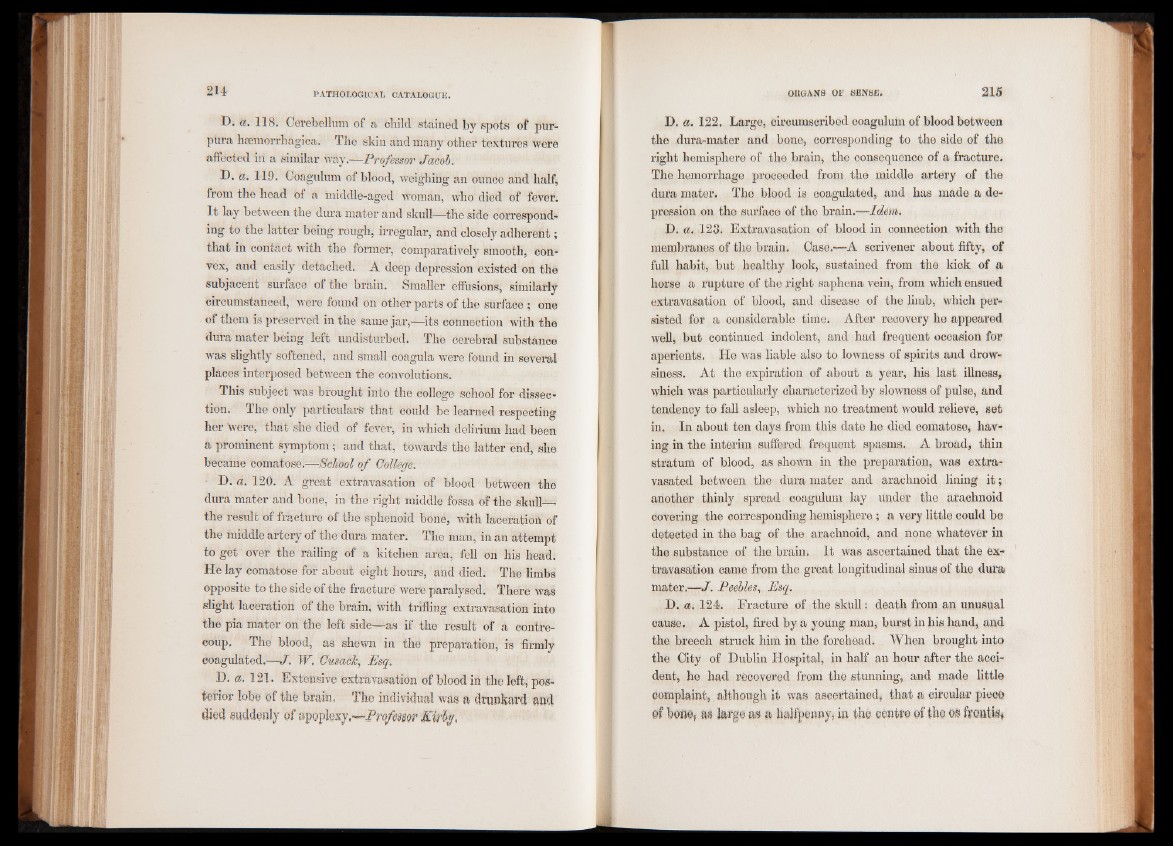
D. a. 118. Cerebellum of a child stained by spots of purpura
hsemorrhagica. The skin and many other textures were
affected in a similar way.—Professor Jacob.
D. a. 119. Coagulum of blood, weighing an ounce and half,
from the head of a middle-aged woman, who died of fever.
It lay between the dura mater and skull—the side corresponding
to the latter being rough, irregular, and closely adherent;
that in contact with the former, comparatively smooth, convex,
and easily detached. A deep depression existed on the
subjacent surface of the brain. Smaller effusions, similarly
circumstanced, were found on other parts of the surface ; one
of them is preserved in the same jar,—its connection with the
dura mater being left undisturbed. The cerebral substance
was slightly softened, and small coagula were found in several
places interposed between the convolutions.
This subject was brought into the college school for dissection.
The only particulars that could be learned respecting
her were, that she died of fever, in which delirium had been
a prominent symptom; and that, towards the latter end, she
became comatose.—School of College.
■ D. a. 120. A great extravasation of blood between the
dura mater and bone, in the right middle fossa of the skull—
the result of fracture of the sphenoid bone, with laceration of
the middle artery of the dura mater. The man, in an attempt
to get over the railing of a kitchen area, fell on his head.
He lay comatose for about eight hours, and died. The limbs
opposite to the side of the fracture were paralysed. There was
slight laceration of the brain, with trifling extravasation into
the pia mater on the left side—as if the result of a contTe-
coup. The blood, as shewn in the preparation, is firmly
coagulated.—J. W, Cusack, Esq,
D . a. 121. Extensive extravasation of blood in the left, posterior
lobe of the brain, The individual was a drunkard and
died suddenly of apoplexy,—Professor Kirby,
D. a. 122. Large, circumscribed coagulum of blood between
the dura-mater and bone, corresponding to the side of the
right hemisphere of the brain, the consequence of a fracture.
The hemorrhage proceeded from the middle artery of the
dura mater. The blood is coagulated, and has made a depression
on the surface of the brain.—Idem.
D. a. 123. Extravasation of blood in connection with the
membranes of the brain. Case.—A scrivener about fifty, of
full habit, but healthy look, sustained from the kick of a
horse a rupture of the right saphena vein, from which ensued
extravasation of blood, and disease of the limb, which persisted
for a considerable time. After recovery he appeared
well, but continued indolent, and had frequent occasion for
aperients. He was liable also to lowness of spirits and drowsiness.
At the expiration of about a year, his last illness,
which was particularly characterized by slowness of pulse, and
tendency to fall asleep, which no treatment would relieve, set
in. In about ten days from this date he died comatose, having
in the interim suffered frequent spasms. A broad, thin
stratum of blood, as shown in the preparation, was extra-
vasated between the dura mater and arachnoid lining it ;
another thinly spread coagulum lay under the arachnoid
covering the corresponding hemisphere ; a very little could be
detected in the bag of the arachnoid, and none whatever in
the substance of the brain. It was ascertained that the extravasation
came from the great longitudinal sinus of the dura
mater.—J. Peebles, Esq.
D. a. 124. Fracture of the skull : death from an unusual
cause. A pistol, fired by a young man, burst in his hand, and
the breech struck him in the forehead. When brought into
the City of Dublin Hospital, in half an hour after the accident,
he had recovered from the stunning, and made little
Complaint, although it was ascertained, that a circular piece
qî boncf as large as a Halfpenny? in the centre of the os froutis?